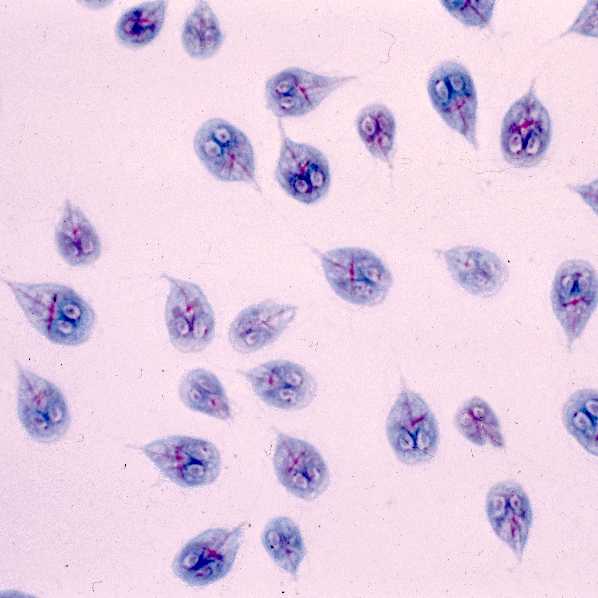Illness & Symptoms

Giardia trophozoites stained with trichrome. Credit: Waterborne Disease Prevention Branch, CDC
Giardiasis is the most frequently diagnosed intestinal parasitic disease in the United States and among travelers with chronic diarrhea 1. Signs and symptoms may vary and can last for 1 to 2 weeks or longer 2,5. In some cases, people infected with Giardia have no symptoms 2-4.
- Diarrhea
- Gas
- Greasy stools that tend to float
- Stomach or abdominal cramps
- Upset stomach or nausea/vomiting
- Dehydration (loss of fluids)
Other, less common symptoms include itchy skin, hives, and swelling of the eye and joints 2,7,8. Sometimes, the symptoms of giardiasis might seem to resolve, only to come back again after several days or weeks. Giardiasis can cause weight loss and failure to absorb fat, lactose, vitamin A and vitamin B12 2,4,9-12.
In children, severe giardiasis might delay physical and mental growth, slow development, and cause malnutrition 2,11,13-17.
References
- Huang DB, White AC. An updated review on Cryptosporidium and Giardia. Gastroenterol Clin North Am. 2006;35(2):291-314, viii.
- Robertson LJ, Hanevik K, Escobedo AA, Morch K, Langeland N. Giardiasis--why do the symptoms sometimes never stop? Trends Parasitol. 2010;26(2):75-82.
- Nash TE, Herrington DA, Losonsky GA, Levine MM. Experimental human infections with Giardia lamblia. J Infect Dis. 1987;156(6):974-84.
- Gardner TB, Hill DR. Treatment of giardiasis. [PDF - 15 pages] Clin Microbiol Rev. 2001;14(1):114-28.
- Escobedo AA, Cimerman S. Giardiasis: a pharmacotherapy review. Expert Opin Pharmacother. 2007;8(12):1885-1902.
- Farthing MJ. Giardiasis. Gastroenterol Clin North Am. 1996;25(3):493-515.
- Wolfe MS. Giardiasis. [PDF - 8 pages] Clin Microbiol Rev. 1992;5(1):93-100.
- Borman P, Seckin U, Ozoran K. Beaver fever--a rare cause of reactive arthritis. J Rheumatol. 2001;28(3):683.
- Hill DR. Giardia lamblia. In: Gillespie SH, Pearson RD, eds. Principles and practice of clinical parasitology. Chisester, England: Joan Wiley & Sons; 2001.
- Notis WM. Giardiasis and vitamin B 12 malabsorption. Gastroenterology. 1972;63(6):1085.
- Farthing MJ. Giardia comes of age: progress in epidemiology, immunology and chemotherapy. [PDF - 4 pages] J Antimicrob Chemother. 1992;30(5):563-6.
- Solomons NW. Giardiasis: nutritional implications. Rev Infect Dis. 1982;4(4):859-69.
- Sullivan PB, Marsh MN, Phillips MB, Dewit O, Neale G, Cevallos AM, Yamson P, Farthing MJ. Prevalence and treatment of giardiasis in chronic diarrhoea and malnutrition. [PDF - 3 pages] Arch Dis Child. 1991;66(3):304-6.
- Farthing MJ, Mata L, Urrutia JJ, Kronmal RA. Natural history of Giardia infection of infants and children in rural Guatemala and its impact on physical growth. Am J Clin Nutr. 1986;43(3):395-405.
- Berkman DS, Lescano AG, Gilman RH, Lopez SL, Black MM. Effects of stunting, diarrhoeal disease, and parasitic infection during infancy on cognition in late childhood: a follow-up study. Lancet. 2002;359(9306):564-71.
- Newman RD, Moore SR, Lima AA, Nataro JP, Guerrant RL, Sears CL. A longitudinal study of Giardia lamblia infection in north-east Brazilian children. Trop Med Int Health. 2001;6(8):624-34.
- Botero-Garces JH, Garcia-Montoya GM, Grisales-Patino D, Aguirre-Acevedo DC, Alvarez-Uribe MC. Giardia intestinalis and nutritional status in children participating in the complementary nutrition program, Antioquia, Colombia, May to October 2006. Rev Inst Med Trop Sao Paulo. 2009;51(3):155-62.
- Page last reviewed: July 21, 2015
- Page last updated: July 21, 2015
- Content source:


 ShareCompartir
ShareCompartir